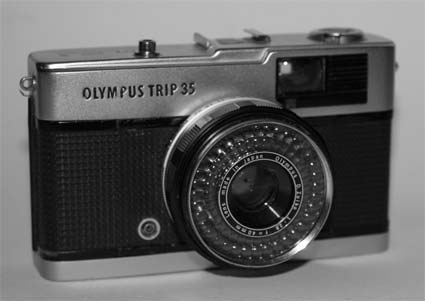
 |
|
Though you wouldn’t
think it, the Olympus TRIP 35 is a quite sophisticated 35 mm
camera and an easy to carry travelling companion.
Its key characteristic is an auto-exposure system operated by a selenium
photo-electric cell light meter which is controlling the lens aperture.
Unless you are using a flashgun, the aperture ring must be set to "A"
for automatic. The camera will then adjust the aperture as required.
|
|

Olympus TRIP 35 (1968-1983) |
When light is
missing, a red flag pops up in the viewfinder and the shutter is
locked.
The only thing
which needs to be adjusted is the focus ring. This one is marked with
distances on the ring’s underside for the rare occasions when you need
to be that accurate, and with symbols on the top of the ring - a head
and shoulders to indicate 1 metre, two figures to indicate 1.5 metres,
three figures to indicate 3 metres and mountain peaks to indicate
infinity.
The
film advance
wheel is used to wind on the
shutter. That done, just
point and shoot.
This camera doesn't
have a built in flash but a flashgun can be installed into the hotshoe.
When using a flashgun, the operator must set the aperture ring to the
“for flash” position. |
|
Caution
: The
hotshoe is synchronized for bulb flash only. Synchronization with
electronic flash can be done using the PC synchro located on the bottom
right of the front face.
In order to not
frustrate expert photographers, it was also possible to set aperture
manually from 1:2,8 to 1:22. The lens is a D.Zuiko 40mm 1:2.8-22
with
4 elements in 3 groups.
The
viewfinder has a main frame and markers to indicate the slight framing
adjustment required
in order to offset the
parallax error,
induced under 1 meter focusing,
by the lens and
viewfinder being in different positions.
There is also a
cleverly
window within the
viewfinder through which the aperture and distance marks can be
controlled.
|
|
This camera has been offered to me by Didier, a friend of mine,
who is a talented photographer and
like me
addicted to old cameras. But above all, Didier is a great philanthropist
(visit
his
blog
dedicated to
the orphan
children, victims of AIDS
in Bouaké,
Africa). |
 Nombre
de visiteurs Nombre
de visiteurs
Number of visitors |


![]()
